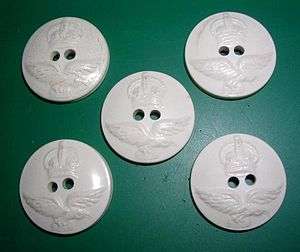Galalith

Galalith (Erinoid in the United Kingdom) is a synthetic plastic material manufactured by the interaction of casein and formaldehyde. Given a commercial name derived from the Greek words gala (milk) and lithos (stone), it is odourless, insoluble in water, biodegradable, antiallergenic, antistatic and virtually nonflammable.
Discovery
In 1897, the Hanover, Germany mass printing press owner Wilhelm Krische was commissioned to develop an alternative to blackboards.[1] The resultant horn-like plastic made from the milk protein casein was developed in cooperation with the Austrian chemist (Friedrich) Adolph Spitteler (1846–1940). The final result was unsuitable for the original purpose.[1] In 1893, French chemist Auguste Trillat discovered the means to insolubilize casein by immersion in formaldehyde.
Production and usage
Although it could not be moulded once set, and was hence produced in sheets, it was inexpensive to produce due to its simple manufacture. Galalith could be cut, drilled, embossed and dyed without difficulty, and its structure manipulated to create a series of effects. No other plastic at the time could compete on price, and with ivory, horn and bone products becoming far more expensive, it found a natural home in the fashion industry.[1]
This new plastic was presented at Paris Universal Exhibition in 1900. In France, Galalith was distributed by the Compagnie Française de Galalithe located near Paris in Levallois-Perret. As a result, the Jura area became the first one to use the material.
Marketed in the form of boards, pipes and rods, in 1913 thirty million litres (eight million US gallons) of milk were used to produce Galalith in Germany alone.[1] In 1914, Syrolit Ltd gained the license for manufacture in the United Kingdom. Renaming itself Erinoid Ltd, it started manufacture in the Lightpill former woollen mill in Dudbridge, Stroud, Gloucestershire.[2]
Galalith could produce gemstone imitations that looked strikingly real. In 1926 Gabrielle “Coco” Chanel published a picture of a short, simple black dress in Vogue. It was calf-length, straight, and decorated only by a few diagonal lines. Vogue called it "Chanel’s Ford,” as like the Model T, the little black dress was simple and accessible for women of all social classes. To accessorize the little black dress, Chanel revamped her designs, thus facilitating the breakthrough and mass popularity of costume jewelry.[1] Galalith was used for striking Art Deco jewelry designs by artists such as Jacob Bengel and Auguste Bonaz, as well as for hair combs and accessories. By the 1930s, Galalith was also used for pens, umbrella handles, white piano keys (replacing natural ivory), and electrical goods,[3] with world production at that time reaching 10,000 tons.
Today
Although Galalith was historically cheap, the fact it could not be moulded led to its demise by commercial end users. Production slowed as the restrictions of World War II led to a need for milk as a food, and niched due to new oil-derived wartime plastic developments. Production continued in Brazil until the 1960s.
References
- 1 2 3 4 5 Christel Trimborn (August 2004). "Jewelry Stone Make of Milk". GZ Art+Design. Retrieved 2010-05-17.
- ↑ "A History of the County of Gloucester: Volume 11: Bisley and Longtree Hundreds (1976)". british-history.ac.uk. Retrieved 2010-05-14.
- ↑ Otto (2004). Stone from milk. Ascent and fall of the Galaliths. Chemistry in our time.
